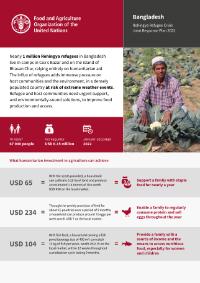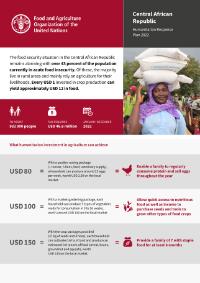
FAO in the 2022 humanitarian appeals
TO ASSIST: 50 million people
FAO REQUIRES: USD 1.5 billion
PERIOD: January–December 2022

FAO in the 2022 humanitarian appeals
12/2021
Emergency livelihoods assistance responds to immediate hunger needs – ensuring nutritious food is produced right where it is needed most – and provides a path out of protracted and deepening food crises.
It has been more than 10 years since the world faced such a risk of widespread famine. In four countries, 584 000 people are living in famine conditions. Elsewhere, an additional 45 million are at a tipping point. Intensifying and spreading conflicts, climate extremes and the continued effects of the COVID-19 pandemic have pushed more and more people to the brink.
Despite this, the agriculture component of the 2021 humanitarian appeals was massively underfunded. Major seasons have passed and with those, a vital opportunity to secure a steady livelihood. Growing numbers of people are forced to rely on food assistance for seemingly endless periods.
It is time to take agriculture seriously. Agriculture is among the most cost‑effective humanitarian frontline interventions. Emergency livelihoods assistance responds to immediate hunger needs – ensuring nutritious food is produced right where it is needed most – and provides a path out of protracted and deepening food crises. While food assistance provided after the worst-case scenario materializes is critical, if we don’t start giving equal priority to investments aimed at rebooting local agricultural production to save lives and making agriculture in vulnerable countries more resilient, 2022 will look just like 2021 – or worse.
In depth

Afghanistan: Humanitarian Response Plan 2022
06/2022
Currently, nearly one in two Afghans do not have adequate means to produce or access food for themselves and their families each day.

Bangladesh: Rohingya Refugee Crisis Joint Response Plan 2022
04/2022
Nearly 1 million Rohingya refugees in Bangladesh live in camps in Cox’s Bazar and on the island of Bhasan Char, relying entirely on humanitarian aid.

Burkina Faso: Humanitarian Response Plan 2022
04/2022
More than half of Burkina Faso is experiencing conflict and insecurity, forcing thousands from their homes, disrupting livelihoods and further aggravating the food security situation.

Cameroon: Humanitarian Response Plan 2022
06/2022
In Cameroon, the prolonged armed conflict, the influx of refugees from neighbouring countries as well as the impact of climate change, with limited rains and long dry spells, are exacerbating the vulnerability of millions of Cameroonians.

Central African Republic: Humanitarian Response Plan 2022
04/2022
The food security situation in the Central African Republic remains alarming with over 43 percent of the population currently in acute food insecurity. Of these, the majority live in rural areas and mainly rely on agriculture for their livelihoods.
